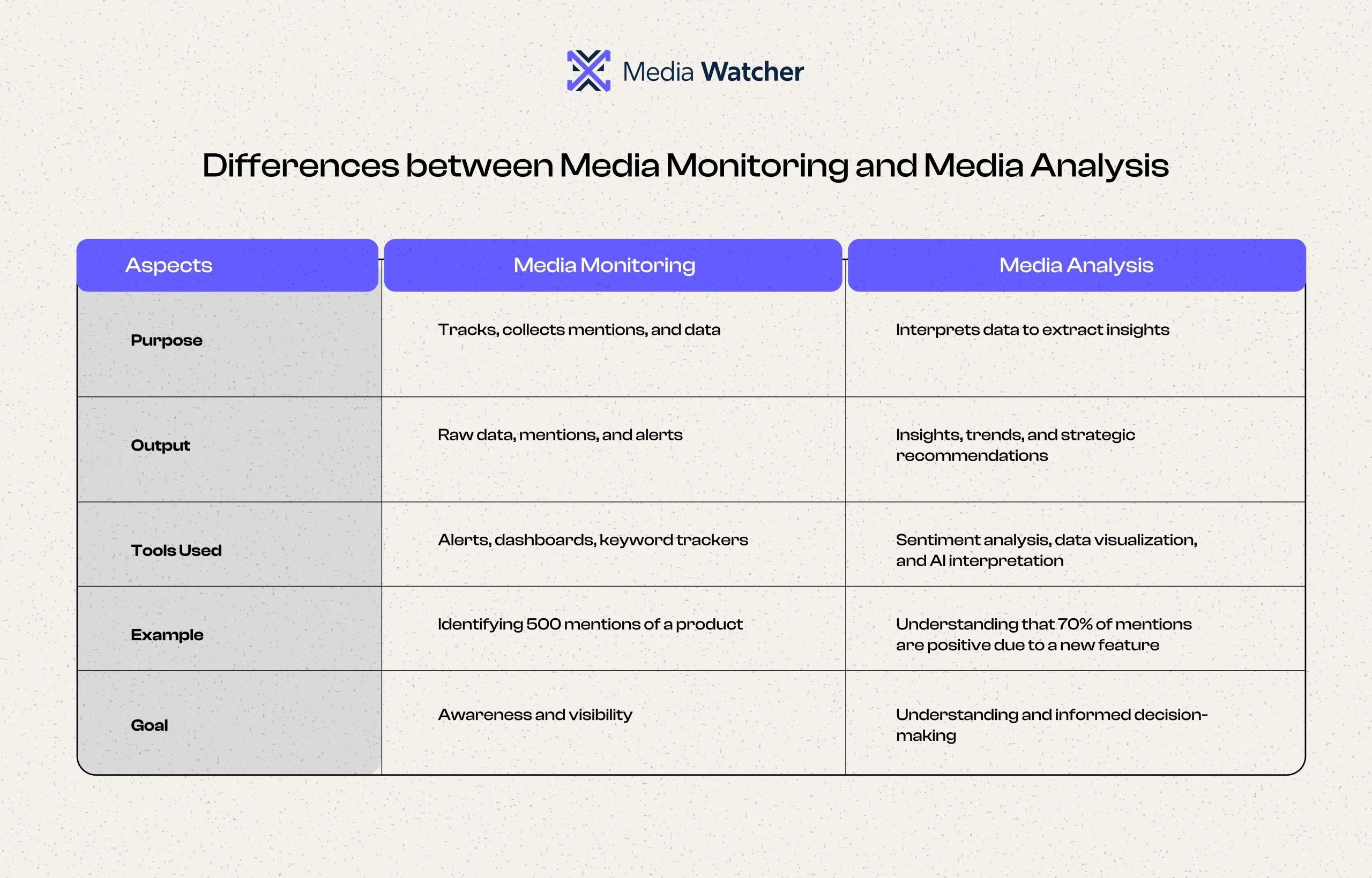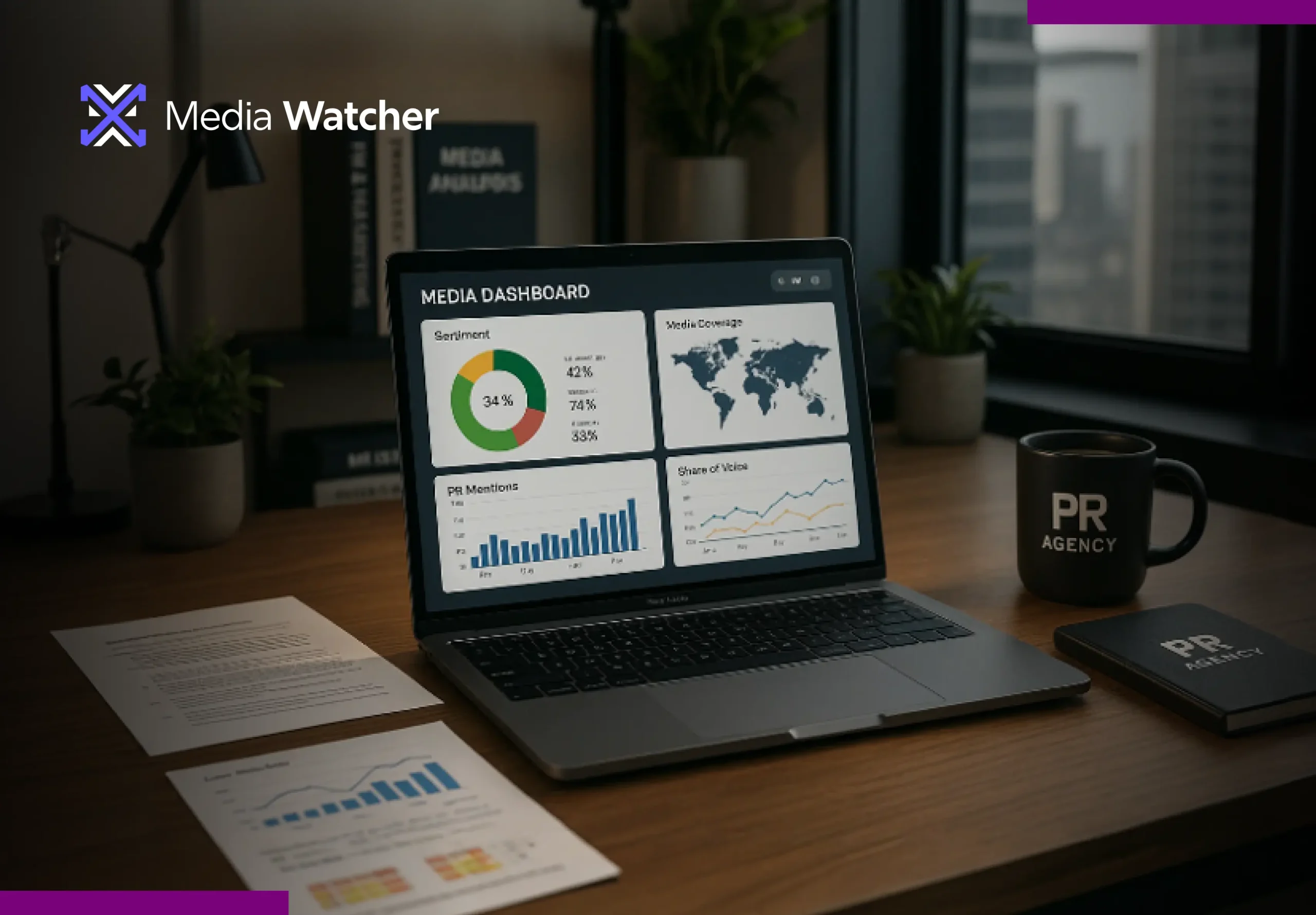Each reference to a brand has a narrative; some develop trust, others provoke concerns. However, the majority of organizations listen to what is being said but not what is meant.
Therefore, to comprehend the difference between media monitoring and media analysis, one should seek the distinction between the words that are being delivered and also the meaning that the words carry.
Media monitoring helps to track references of the brand in multiple touchpoints, and media analysis digs deeper to know the tone, the mood, and the reaction of the audience.
Both media monitoring and media analysis collectively give a whole picture, beginning with awareness and leading to perception, allowing brands to make informed decisions in time. And after all, it is not merely the hearing of the talk that is really going to grow one, but rather putting oneself into the position of feeling what it is aiming to convey.
What is Media Monitoring?
Media monitoring refers to the act of tracking, collecting, and dissecting information that is available in various media sources in order to discover how a brand, a person, and a topic are represented within the context of the public.
It entails maintaining a careful watch on the news releases, online platforms, social media, and web circles to detect the mentions, views, and changing stories. In addition to mere tracking, media monitoring helps organizations to feel the rhythm of mass opinion, predict difficulties, and find useful opportunities in the conversation.
It allows companies to protect their reputation, optimize communication tools, and direct their story with a sense of authority and accuracy.
What is a Media Analysis?
Media analysis is the strategic act of analyzing and understanding media materials in order to derive significant implications concerning the manner in which a brand or a subject is being framed.
It does not just monitor mentions, it interprets emotions, context, and intent of conversations in the public on news, social platforms, and online forums. Media analysis converts raw information into actionable intelligence through advanced analytics and sentiment testing.
Major Differences between Media Monitoring and Media Analysis
Media monitoring and media analysis are two terms that are synonymous, although they play differing roles in the media intelligence process. The basis is media monitoring; it involves gathering information and references in different media outlets.
It is meant to keep track of who is discussing a brand, what is said, and how often. As an example of a company launching a new product, media monitoring analysis helps to observe the number of times the product is mentioned on the Internet, on which platforms the mentions appear, and whether the popularity is rising or falling. It will give the business a clear view of its visibility and allow it to be alert to the trends or short bursts of interest.
An Example of Media Monitoring
For example, a skincare company has launched its products and uses AI media monitoring to track all internet mentions of its goods on social media, news, and forums. It will be able to find the spike in customer reviews with a word about allergic reactions within hours, and the team can respond in time and manage the discussion before it grows out of control through news media monitoring protocols.
How Media Analysis Adds Deeper Insight?
Media analysis, however, goes a step further with the process. After collecting the information, the analysis explains it, revealing the feelings, trends, and connotations of the discussions. It identifies the positive, negative, or neutral sentiments of people discussing a topic and the underlying motivations of their thoughts through methods such as sentiment analysis or audience segmentation.
An Example of Media Analysis
Let’s understand it with an example: the brand conducts media analysis after weeks of online conversations on the same skincare line to learn the general mood and themes. The tracked insights reveal that customers value the product outcomes, but they also feel that its packaging is inconvenient, which eventually helps this company improve its future campaigns and product design.

How does the Media Monitoring Platform Work?
Consider a media monitoring platform as a very inquisitive assistant keeping a watchful eye at all times. You give it what you care about, first, keywords, brand name, or topic, and it starts surfing the media platforms, searching news media and sites, blogs, forums, social channels, podcasts, and so on. It collects all the relevant mentions, however small, and brings them together in a single location so that one does not need to hunt them down.
It then filters and refines that ton of data into actionable information. References are categorized on the basis of relevance, tone, reach, and context, which form the basis of further analysis of the media monitoring.
It assists in determining which conversation threads are gaining momentum, where they are occurring, and who is leading them. Certain platforms even warn about sudden spikes or possible problems before they develop. That way, the platform filters the noise into a signal, which helps you remain alert, responsive, and strategic.
Working Operations of Media Analysis Platform
Behind each keen marketing move is an assortment of insights that came out of unremitting observation and interpretation. A media analysis platform is the invisible hand that takes the associated online discussions and orders them into systematic intelligence.
Media Analysis differs from media monitoring in that it does not just show mentions but researches tone, relevance, and influence to reveal what is actually of importance to the image of a brand. Flexibility in making responses within a constantly changing digital world is provided by automation, coupled with intelligent analysis, which enables businesses to respond more intelligently.
The way its main operations work is as follows:
- Contextual Filtering: It eliminates irrelevant conversations, and only the meaningful mentions that have an impact on perception or reputation are stored.
- Sentiment and Tone Analysis: It applies sentiment detection, which is an AI service, to evaluate the emotional constituent of every mention, to classify the media tone as positive, neutral, or negative.
- Trend and Impact Assessment: It identifies the market opportunities or threats by having common themes, trends, or coverage spikes.
- Reporting and Visualization: The collected insights are then displayed as easy-to-understand analytics reports and dashboards to respond to the strategies faster.
How Combining Media Monitoring and Media Analysis Enhances Business Value?
The rate of media expansion has been quite phenomenal in recent years: companies today are watching 12.5 media channels, on average, compared to about 5.8 a few years ago. Media monitoring is particularly effective in keeping track of this diversity when it comes to catching references, dialogues, and cues as they arise.
But raw mentions are just surface-level. This is where media analysis comes in, which gets into the tone, sentiment, and context. When combined, they provide business leaders with more than awareness, offering real-time adaptability. When a crisis starts tearing apart the media, AI media monitoring gives early warning and helps you understand why people are acting as they are, giving you time to respond accurately.
This combination is supported by research in terms of ROI; the global media monitoring market reached $5.40 billion in 2025 and is expected to increase to $9.19 billion by 2030, most of which is motivated by the demand to integrate monitoring and analytics tools. It is not a matter of fancy dashboards, but rather firms utilizing the chatter in the media as strategic intelligence.
As an example, a monitoring tool can assist in identifying spikes in negative sentiment early, and analysis can then be used to determine whether the negativity is due to a product problem, a failure of customer service, or a miscommunication. Those businesses that employ both report higher rates of swiftly detecting threats to their brand, stronger campaign results, and more effective resource allocation.
In addition to risk management, the integration of media monitoring and analysis leads to market and product strategy. By keeping track, firms can define trending topics, rival actions, or available unexploited customer feedback. Analysis then informs them of what those trends actually represent and whether they are something worth following.
A single study observed that the positioning and reputation of companies based on the use of market intelligence (a combination of monitoring and analysis) had improved, and cited that about 51% of brands now regard social media monitoring as a key part of controlling their brand image.
How Media Watcher Combines Media Monitoring and Media Analysis into One Powerful Platform?
The information in the digital world travels more rapidly than ever. The brand needs to listen and also to make sense. Media Watcher fills this gap by integrating media monitoring and leading software for media analysis into one intelligent ecosystem that maps fragmented data into strategic clarity. It does not just gather mentions, but makes sense out of them, their tone, and their effect to provide a business with a clear picture of how the public perception influences the outcomes in the business.
This is how Media Watcher can offer accuracy and clarity within one platform:
- Centralized Data Monitoring: It continuously scans social sites, blogs, forums, and news outlets to track all the references made to a brand, product, or topic in real time.
- Data Visualization Dashboard: All insights are presented in user-friendly dashboards displaying the principal performance tendencies, sentiment changes, and media coverage analysis on one screen.
- Alerts Generation and Strategy Advice: The brand name and decision-making can be better with real-time notifications and trend forecasts, helping companies take control before issues get out of control.
Contact the Media Watcher team and book a free demo today!




